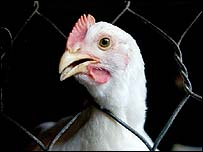Deadly ingredient in H5N1
 Researchers at St Jude Children's Hospital learned about genes that make up more than 2000 different viruses, from birds, from humans and other animals.
Researchers at St Jude Children's Hospital learned about genes that make up more than 2000 different viruses, from birds, from humans and other animals.
The results of the study, published in the journal Science Science, show a significant difference between the types of bird flu and seasonal influenza in humans.
This difference may be the cause of deaths from bird flu.
Currently, the H5N1 avian influenza virus, raging in the Far East, Central Asia and Turkey, is a deadly virus. Up to half of patients infected with this virus died.
However, this virus does not spread much. The fear of the emergence of a new, more infectious variant has been drowned out by the hope that the virus is also becoming less dangerous.
However, new research shows that the situation is not so.
The infection depends on the protein components of the virus, H and N components, which are used to name the virus, and researchers have discovered changes in another molecule. , called NS1, can alter the virus.
A small part of NS1 in avian influenza virus has the ability to alter cellular functions.
In the seasonal flu virus in people without this ingredient.
It is worth mentioning that in all cases of human infection with H5N1 infection, there is also evidence of the existence of this destructive component, including in virus samples that once killed about 30 million people. back in the pandemic of 1918 before.
Currently, it is concerned that the avian influenza virus variant is more contagious , does not affect the composition of NS1 protein, and so the avian influenza virus is still as deadly as it was.
- Detects antibodies against many types of flu
- The 9th death due to H5N1 infection in Cambodia
- Key protein detection in H5N1 virus
- Successful early in blocking deadly flu virus
- The H5N1 variant can spread to humans through respiration
- WHO caucus about the most dangerous virus created by humans
- H5N1 flu appears in poultry in Ninh Thuan
- 5 mutations make bird flu a pandemic
- Pandemic H5N1 has returned
- Bad developments in H5N1 in Asia and Europe
- Detection of the H5N1 virus strain by a test
- 100% of people infected with H5N1 in 2009 died
 March 2012: Launching H5N1 vaccine for poultry
March 2012: Launching H5N1 vaccine for poultry Experts comment on the mysterious gradual disappearance of the Delta variant in Japan
Experts comment on the mysterious gradual disappearance of the Delta variant in Japan Danger of the two Delta . branch variants
Danger of the two Delta . branch variants 2020 pandemic flu attack humans?
2020 pandemic flu attack humans?